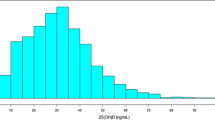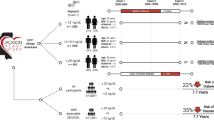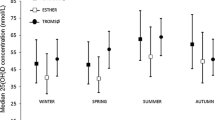Abstract
Objective
To determine the prevalence and predictors of vitamin D insufficiency among black and white adult residents of the southern US.
Methods
A cross-sectional analysis of serum 25(OH)D levels using baseline blood samples from 395 Southern Community Cohort Study (SCCS) participants. Participants were African-American and white adults aged 40–79 who enrolled in the study from 2002–2004. We defined hypovitaminosis D as serum 25(OH)D levels ≤15 ng/ml.
Results
Hypovitaminosis D prevalence was 45% among blacks and 11% among whites. Vitamin D intake from diet and supplements was associated with modest increases in circulating 25(OH)D (0.5–0.7 ng/ml per 100 IU increment), but hypovitaminosis D was found for 32% of blacks with intake ≥400 IU/day. Body mass index (BMI) was a strong predictor of risk for hypovitaminosis D among black women (OR = 6.5, 95% CI 1.7–25.1 for BMI ≥30 kg/m2 vs. 18–24.9 kg/m2). UVR exposure estimated by residential location was positively associated with 25(OH)D levels among all groups except white women.
Conclusions
Hypovitaminosis D was present in a substantial proportion of the African-American population studied, even in the South and among those meeting recommended dietary guidelines. Vitamin D should continue to be a studied target for ameliorating racial cancer disparities in the US.


Similar content being viewed by others
References
Calvo MS, Whiting SJ, Barton CN (2005) Vitamin D intake: a global perspective of current status. J Nutr 135:310–316
Holick MF (2007) Vitamin D deficiency. N Engl J Med 357:266–281
Harris SS, Soteriades E, Coolidge JA et al (2000) Vitamin D insufficiency and hyperparathyroidism in a low income, multiracial, elderly population. J Clin Endocrinol Metab 85:4125–4130
Nesby-O’Dell S, Scanlon KS, Cogswell ME et al (2002) Hypovitaminosis D prevalence and determinants among African American and white women of reproductive age: third national health and nutrition examination survey, 1988–1994. Am J Clin Nutr 76:187–192
Weisberg P, Scanlon KS, Li R et al (2004) Nutritional rickets among children in the United States: review of cases reported between 1986 and 2003. Am J Clin Nutr 80:1697S–1705S
Wortsman J, Matsuoka LY, Chen TC et al (2000) Decreased bioavailability of vitamin D in obesity. Am J Clin Nutr 72:690–693
Pogue SJ (1995) Vitamin D synthesis in the elderly. Dermatol Nurs 7:103–105
Clemens TL, Adams JS, Henderson SL et al (1982) Increased skin pigment reduces the capacity of skin to synthesise vitamin D3. Lancet 1:74–76
Hollis BW (2005) Circulating 25-hydroxyvitamin D levels indicative of vitamin D sufficiency: implications for establishing a new effective dietary intake recommendation for vitamin D. J Nutr 135:317–322
Dawson-Hughes B (2004) Racial/ethnic considerations in making recommendations for vitamin D for adult and elderly men and women. Am J Clin Nutr 80:1763S–1766S
Signorello LB, Hargreaves MK, Steinwandel MD et al (2005) Southern community cohort study: establishing a cohort to investigate health disparities. J Natl Med Assoc 97:972–979
Buchowski MS, Schlundt DG, Hargreaves MK et al (2003) Development of a culturally sensistive food frequency questionnaire for use in the Southern community cohort study. Cell Mol Biol 49:1295–1304
Hollis BW, Kamerud JQ, Selvaag SR et al (1993) Determination of vitamin D status by radioimmunoassay with an 125I-labeled tracer. Clin Chem 39:529–533
Yanoff LB, Parikh SJ, Spitalnik A et al (2006) The prevalence of hypovitaminosis D and secondary hyperparathyroidism in obese Black Americans. Clin Endocrinol (Oxf) 64:523–529
Thomas MK, Lloyd-Jones DM, Thadhani RI et al (1998) Hypovitaminosis D in medical inpatients. N Engl J Med 338:777–783
Webb AR, Pilbeam C, Hanafin N, Holick MF (1990) An evaluation of the relative contributions of exposure to sunlight and of diet to the circulating concentrations of 25-hydroxyvitamin D in an elderly nursing home population in Boston. Am J Clin Nutr 51:1075–1081
Standing Committee on the Scientific Evaluation of Dietary Reference Intakes Food, Nutrition Board, Institute of Medicine. (1999) Vitamin D. In: Dietary references intakes for calcium, phosphorus, magnesium, vitamin D, and fluoride. National Academy Press, Washington, DC, pp 250–287
Dawson-Hughes B, Heaney RP, Holick MF et al (2005) Estimates of optimal vitamin D status. Osteoporos Int 16:713–716
Vieth R (2004) Why the optimal requirement for Vitamin D3 is probably much higher than what is officially recommended for adults. J Steroid Biochem Mol Biol 89–90:575–579
Bischoff-Ferrari HA, Giovannucci E, Willett WC et al (2006) Estimation of optimal serum concentrations of 25-hydroxyvitamin D for multiple health outcomes. Am J Clin Nutr 84:18–28
Kimlin MG (2004) The climatology of Vitamin D producing ultraviolet radiation over the United States. J Steroid Biochem Mol Biol 89–90:479–483
Buchowski MS, Semenya J, Johnson AO (2002) Dietary calcium intake in lactose maldigesting intolerant and tolerant African–American women. J Am Coll Nutr 21:47–54
Jarvis JK, Miller GD (2002) Overcoming the barrier of lactose intolerance to reduce health disparities. J Natl Med Assoc 94:55–66
Radimer K, Bindewald B, Hughes J et al (2004) Dietary supplement use by US adults: data from the National Health and Nutrition Examination Survey, 1999–2000. Am J Epidemiol 160:339–349
Moore C, Murphy MM, Keast DR et al (2004) Vitamin D intake in the United States. J Am Diet Assoc 104:980–983
Byers KG, Savaiano DA (2005) The myth of increased lactose intolerance in African–Americans. J Am Coll Nutr 24:569S–573S
Calvo MS, Whiting SJ (2006) Public health strategies to overcome barriers to optimal vitamin D status in populations with special needs. J Nutr 136:1135–1139
Looker AC (2005) Body fat and Vitamin D status in black versus white women. J Clin Endrocrinol Metab 90:635–640
Zadshir A, Tareen N, Pan D, Norris K, Martins D (2005) The prevalence of hypovitaminosis D among US adults: data from the NHANES III. Ethn Dis 15:97–101
Feskanich D, Ma J, Fuchs CS et al (2004) Plasma vitamin D metabolites and risk of colorectal cancer in women. Cancer Epidemiol Biomarkers Prev 13:1502–1508
Uitterlinden AG, Fang Y, Van Meurs JB et al (2004) Genetics and biology of vitamin D receptor polymorphisms. Gene 338:143–156
Schwartz GG, Whitlatch LW, Chen TC et al (1998) Human prostate cells synthesize 1,25-dihydroxyvitamin D3 from 25-hydroxyvitamin D3. Cancer Epidemiol Biomarkers Prev 7:391–395
Zehnder D, Bland R, Williams MC et al (2001) Extrarenal expression of 25-hydroxyvitamin d(3)-1 alpha-hydroxylase. J Clin Endocrinol Metab 86:888–894
Lin R, White JH (2004) The pleiotropic actions of vitamin D. Bioessays 26:21–28
Lowe L, Hansen CM, Senaratne S et al (2003) Mechanisms implicated in the growth regulatory effects of vitamin D compounds in breast cancer cells. Recent Results Cancer Res 164:99–110
Bao BY, Yao J, Lee YF (2006) 1{alpha}, 25-dihydroxyvitamin D3 suppress interleukin-8-mediated prostate cancer cell angiogenesis. Carcinogenesis 27:1883–1893
Furigay P, Swamy N (2004) Anti-endothelial properties of 1,25-dihydroxy-3-epi-vitamin D3, a natural metabolite of calcitriol. J Steroid Biochem Mol Biol 89–90:427–431
Nakagawa K, Sasaki Y, Kato S et al (2005) 22-Oxa-1alpha,25-dihydroxyvitamin D3 inhibits metastasis and angiogenesis in lung cancer. Carcinogenesis 26:1044–1054
Garland CF, Garland FC (1980) Do sunlight and vitamin D reduce the likelihood of colon cancer? Int J Epidemiol 9:227–231
Grant WB (2003) Ecologic studies of solar UV-B radiation and cancer mortality rates. Recent Results Cancer Res 164:371–377
Giovannucci E (2005) The epidemiology of vitamin D and cancer incidence and mortality: a review (United States). Cancer Causes Control 16:83–95
Schwartz GG (2005) Vitamin D and the epidemiology of prostate cancer. Semin Dial 18:276–289
Rukin NJ, Luscombe C, Moon S et al (2007) Prostate cancer susceptibility is mediated by interactions between exposure to ultraviolet radiation and polymorphisms in the 5′ haplotype block of the vitamin D receptor gene. Cancer Lett 247:328–335
Moon S, Holley S, Bodiwala D et al (2006) Associations between G/A1229, A/G3944, T/C30875, C/T48200 and C/T65013 genotypes and haplotypes in the vitamin D receptor gene, ultraviolet radiation and susceptibility to prostate cancer. Ann Hum Genet 70:226–236
Chen WY, Bertone-Johnson ER, Hunter DJ et al (2005) Associations between polymorphisms in the vitamin D receptor and breast cancer risk. Cancer Epidemiol Biomarkers Prev 14:2335–2339
Giovannucci E (2006) The epidemiology of vitamin D and colorectal cancer: recent findings. Curr Opin Gastroenterol 22:24–29
Giovannucci E, Liu Y, Rimm EB et al (2006) Prospective study of predictors of vitamin D status and cancer incidence and mortality in men. J Natl Cancer Inst 98:451–459
Wu K, Feskanich D, Fuchs CS et al (2007) A nested case–control study of plasma 25-hydroxyvitamin D concentrations and risk of colorectal cancer. J Natl Cancer Inst 99:1120–1129
Wactawski-Wende J, Kotchen JM, Anderson GL et al (2006) Calcium plus vitamin D supplementation and the risk of colorectal cancer. N Engl J Med 354:684–696
Lappe JM, Travers-Gustafson D, Davies KM et al (2007) Vitamin D and calcium supplementation reduces cancer risk: results of a randomized trial. Am J Clin Nutr 85:1586–1591
Jemal A, Siegel R, Ward E et al (2006) Cancer statistics, 2006. CA Cancer J Clin 56:106–130
Wudel LJ Jr, Chapman WC, Shyr Y et al (2002) Disparate outcomes in patients with colorectal cancer: effect of race on long-term survival. Arch Surg 137:550–554
Polite BN, Dignam JJ, Olopade OI (2006) Colorectal cancer model of health disparities: understanding mortality differences in minority populations. J Clin Oncol 24:2179–2187
Cooper GS, Yuan Z, Landefeld CS et al (1996) Surgery for colorectal cancer: race-related differences in rates and survival among medicare beneficiaries. Am J Public Health 86:582–586
Dignam JJ, Colangelo L, Tian W et al (1999) Outcomes among African–Americans and Caucasians in colon cancer adjuvant therapy trials: findings from the national surgical adjuvant breast and bowel project. J Natl Cancer Inst 91:1933–1940
Polite BN, Dignam JJ, Olopade OI (2005) Colorectal cancer and race: understanding the differences in outcomes between African Americans and whites. Med Clin North Am 89:771–793
Moan J, Porojnicu AC, Robsahm TE et al (2005) Solar radiation, vitamin D and survival rate of colon cancer in Norway. J Photochem Photobiol B 78:189–193
Schwartz GG (2005) Vitramin D and the epidemiology of prostate cancer. Semin Dial 18:276–289
Li H, Stampfer MJ, Hollis BJ et al (2007) A prospective study of plasma Vitamin D metabolites, Vitamin D receptor polymorphisms, and prostate cancer. PLOS Med 4:562–571
Acknowledgment
The Southern Community Cohort Study is funded by a grant from the National Cancer Institute (R01 CA092447).
Author information
Authors and Affiliations
Corresponding author
Rights and permissions
About this article
Cite this article
Egan, K.M., Signorello, L.B., Munro, H.M. et al. Vitamin D insufficiency among African-Americans in the southeastern United States: implications for cancer disparities (United States). Cancer Causes Control 19, 527–535 (2008). https://doi.org/10.1007/s10552-008-9115-z
Received:
Accepted:
Published:
Issue Date:
DOI: https://doi.org/10.1007/s10552-008-9115-z




